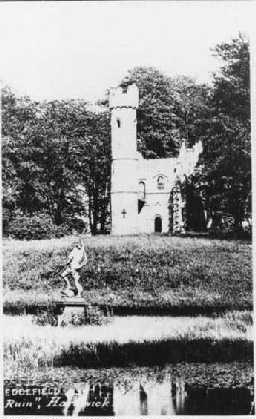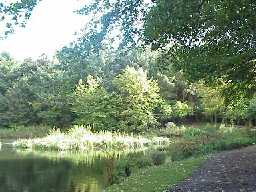Statue of Neptune (Hardwick Park, Sedgefield)

Statue of Neptune with the Gothic ruin. c. 1900

The same view in October 2001. Neptune missing and Gothic Ruin obscured October 2001
At the point where the Serpentine River broadened and turned north below the Ruin, a small circular island stood in the centre of the River. In the centre of the island was a square stone pedestal, and on the pedestal was a lead statue of Neptune. Surviving photographs of Neptune show him to have been substantially identical to the version erected in the market place in Durham in 1730 as part of a later abandoned scheme to make the River Wear navigable from Durham to the sea at Sunderland. The Durham statue, which survives, was cast in lead in London and brought by sea to Newcastle before being transported to Durham. It was paid for by George Bowes of Gibside (then MP for County Durham) and charged to his election expense account. The Durham statue is of high quality and may have been a special commission. The maker is not known, but the most likely candidate is the studio of John Nost (Jan van Ost), and more particularly the sculptor Andrew Carpenter (Andries Carpentière).
Nost died in 1729, but his business was carried on with great success by John Cheere, who achieved considerable fame as a supplier of lead statues, especially for the garden market. Since Burdon's Neptune presumably dated from around 1750, Cheere's yard at Hyde Park Corner would seem the most likely source. The statue remained in position into the 20th century, where it was photographed. It disappeared at some point after 1945.
In 1999 Neptune's Island was described as follows. The circular island survives, much overgrown with rough grass and willow scrub. The stone pedestal can be seen in the centre of the island. Several outlying tussocks of grass blur the shape and scale of the island. The visual relationship between the island and the Ruin has been lost due to the planting of trees across the western side of the Ruin.
Nost died in 1729, but his business was carried on with great success by John Cheere, who achieved considerable fame as a supplier of lead statues, especially for the garden market. Since Burdon's Neptune presumably dated from around 1750, Cheere's yard at Hyde Park Corner would seem the most likely source. The statue remained in position into the 20th century, where it was photographed. It disappeared at some point after 1945.
In 1999 Neptune's Island was described as follows. The circular island survives, much overgrown with rough grass and willow scrub. The stone pedestal can be seen in the centre of the island. Several outlying tussocks of grass blur the shape and scale of the island. The visual relationship between the island and the Ruin has been lost due to the planting of trees across the western side of the Ruin.
D5787
Registered Park or Garden of Historic Interest
• National Heritage List for England Entry Number: 1000730
• National Heritage List for England Entry Number: 1000730
Disclaimer -
Please note that this information has been compiled from a number of different sources. Durham County Council and Northumberland County Council can accept no responsibility for any inaccuracy contained therein. If you wish to use/copy any of the images, please ensure that you read the Copyright information provided.